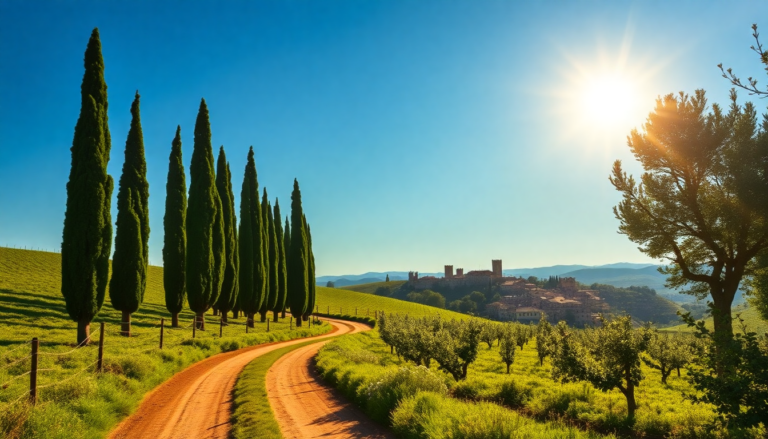Argomenti trattati
The Via Lauretana, winding through the heart of Tuscany from Siena to Cortona, invites travelers to embark on a journey steeped in spirituality, history, and breathtaking landscapes. This ancient pilgrimage route, rich with cultural heritage, offers an immersive experience that transports visitors through picturesque medieval towns, serene countryside, and rolling hills adorned with cypress trees. Whether you’re a seasoned pilgrim or a casual wanderer, the Via Lauretana promises a memorable adventure filled with beauty and reflection.
Understanding the Via Lauretana
The Via Lauretana traces its origins back to Roman times when it served as a secondary route connecting Arezzo to Rome. However, it gained prominence during the Middle Ages as a pilgrimage path leading to the revered Sanctuary of Loreto. Historically, Siena acted as a significant waypoint for pilgrims on their way to Rome and the Holy Land, making it a vital starting point for those heading towards the Marche region. The journey along this path intertwines with the rich tapestry of Tuscany’s cultural and natural beauty.
As you traverse the Via Lauretana today, you will find a well-marked trail that reflects its historical significance. Efforts by local organizations and dioceses to revitalize the route have made it accessible once more, allowing hikers and cyclists to experience the ancient pathways that many have walked before. The 95-kilometer stretch from Siena to Cortona is not only a physical challenge but also a journey into the heart of Tuscany, inviting exploration of the region’s captivating landscapes.
Five essential stages of the journey
The Via Lauretana is divided into five stages, each offering unique experiences and sights. Beginning in Siena, known for its well-preserved medieval architecture and vibrant cultural scene, the journey leads you through the enchanting Crete Senesi and the Val di Chiana. The first stage starts with a gentle exit from Siena, where travelers can immerse themselves in the rural landscape that unfolds beyond the city walls.
As you make your way towards Taverne d’Arbia, you will walk amid the iconic Crete Senesi, characterized by undulating hills and dramatic clay formations. The scenery here is nothing short of breathtaking, providing ample opportunities for photography and contemplation. Along the way, the ancient churches and quaint farmhouses serve as reminders of the area’s rich history.
Continuing the journey: From Rapolano Terme to Sinalunga
After leaving Taverne d’Arbia, the path leads to Rapolano Terme, famous for its sulfur springs. This charming town offers a perfect respite for weary travelers, who can rejuvenate in the thermal baths while reflecting on their journey. The route continues through lush landscapes dotted with olive groves and vineyards, where the tranquility of the countryside envelops you.
Arriving in Sinalunga, perched on a hilltop, offers stunning views of the Val di Chiana. This stage marks the transition into a more fertile area of Tuscany, known for its agriculture and delightful local cuisine. The town’s peaceful atmosphere and historical charm make it a lovely stopover on your pilgrimage.
The final stages: Towards Cortona
The last two stages of the Via Lauretana present both challenges and rewards. As you approach Foiano della Chiana, the terrain becomes flatter, allowing for easier walking. This area, once reclaimed by the Medici, is rich in history and culture. The path is lined with fields and picturesque rural homes, inviting you to savor the beauty of the Tuscan countryside.
The final leg of the journey leads to Cortona, an ancient Etruscan town renowned for its impressive views and artistic heritage. The steep ascent towards Cortona is invigorating, culminating in a sense of accomplishment as you arrive at this historic destination. Here, the rich tapestry of art, history, and spirituality awaits, providing a fitting conclusion to your journey along the Via Lauretana.
Planning your journey
While the Via Lauretana can be tackled on foot, it is also accessible for cyclists, though some preparation is needed due to the terrain. The ideal times to embark on this journey are during the spring and autumn months when the weather is mild, and the landscape is in full bloom or adorned in autumn hues. During these seasons, you can fully appreciate the vibrant colors and natural beauty that Tuscany has to offer.
In contrast, summer can be quite hot, making the trek challenging, while winter brings unpredictable weather. Regardless of the season, proper planning is essential to ensure a safe and enjoyable experience.
What to expect along the way
Throughout your journey, you will encounter various accommodations ranging from local inns to guesthouses, ensuring comfortable resting places after each day’s walk. Each town along the route is also filled with local eateries where you can indulge in traditional Tuscan dishes, such as pici, hearty soups, and exquisite local wines.
As you navigate this beautiful landscape, remember to stay hydrated and carry snacks, especially on the longer stretches where amenities may be sparse. The Via Lauretana beckons travelers to step away from the hustle of modern life, providing a chance to connect with nature, history, and oneself.

